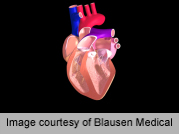
MONDAY, Aug. 12 (HealthDay News) — Adults who were premature babies may be at higher risk for heart problems, a small new study suggests.
Being born prematurely might be associated with important changes in how the heart forms and works during adulthood, the study authors said.
Researchers tracked 102 premature babies from birth into their 20s, and compared them to 132 people born at full term. They found that the right lower heart chamber in young adults who were born prematurely was smaller and heavier, and had thicker walls and less pumping capacity.
The more premature the birth, the greater the effect on right ventricle size and function, according to the study, which appears Aug. 12 in the journal Circulation.
“Up to 10 percent of today’s young adults were born prematurely and some have an altered higher cardiovascular risk profile in adult life,” study leader Paul Leeson, a cardiologist at the University of Oxford’s Cardiovascular Clinical Research Facility in England, said in a journal news release.
“We wanted to understand why this occurs so that we can identify the small group of patients born premature who may need advice from their health care provider about this cardiovascular risk,” he said. “The changes we have found in the right ventricle are quite distinct and intriguing.”
The study found an association between being born prematurely and differences in heart size and function in adulthood, but it didn’t establish a cause-and-effect relationship.
“We are trying to dig deeper into what’s different about the hearts of those born preterm,” study first author Adam Lewandowski said in the news release. “The potential scientific explanations for why their hearts are different are fascinating, and our study adds to the growing understanding of how premature birth shapes future heart health.”
One expert said the study sheds light on the issue.
The finding “provided us with important information about the structure and function of these patients’ hearts, but what remains to be seen is the impact of these findings on overall health and cardiovascular risk,” said Dr. Denise Hayes, a pediatric cardiologist at the Steven & Alexandra Cohen Children’s Medical Center in New Hyde Park, N.Y.
“Further research in this field will help us to optimize the care of our patients in the neonatal period and far into adulthood,” Hayes added.
Similar, slightly smaller differences in a different chamber of the heart — the left ventricle — among people born prematurely were seen in previous research by Leeson’s group.
Although changes in the right ventricle may increase the risk of heart failure and cardiovascular death, the researchers reassured people who were born prematurely that there was no evidence of these problems in the young people in this study.
Another expert noted how the researchers used computer modeling to unearth valuable information about how the heart of someone born prematurely might be structured differently.
The study “is a great example of how computer models can help identify and analyze an individual’s risk,” explained Don Morris, vice president of scientific product & technology development at Archimedes Inc., a subsidiary of Kaiser Permanente. “Mathematical models using data from large studies established a connection between right ventricular structure and heart disease risk, which in turn led to this study of the relationship between prematurity at birth and heart structure.”
“This information can be used today to help with better identification of people at risk so they can be treated proactively, for example, by more careful monitoring and control of blood pressure and cholesterol,” Morris said. “Ultimately, a better understanding of the causes of these heart changes could lead to improvements in neonatal treatment.”
More information
The U.S. Centers for Disease Control and Prevention outlines the health issues of premature babies.
Copyright © 2025 HealthDay. All rights reserved.

